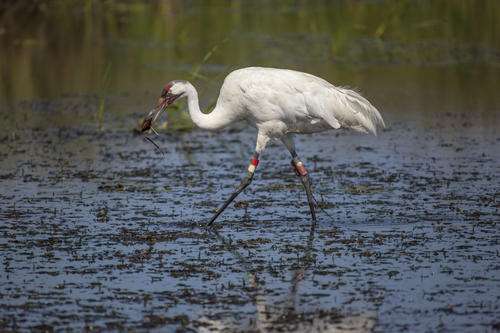Age before youth: Older cranes lead the way to new migration patterns

Bird migration patterns are changing rapidly worldwide due to climate and land use changes, and in the case of the endangered whooping crane, its age before youth, leading the way.
Whooping cranes are changing migration patterns in response to climate and land use change, and these new patterns are being determined by the older , more experienced, members of the population.
Researchers from Senckenberg Biodiversity and Climate Research Centre, the Goethe University Frankfurt, the U.S. Geological Survey, the University of Maryland, and the International Crane Foundation investigated a behavior known as "shortstopping," which is the shortening of a migration route by shifting wintering grounds toward the breeding grounds.
Shortstopping can benefit migrating birds by decreasing the amount of energy that they use on long distance flights. They also can arrive at the breeding grounds earlier, which can be beneficial. This requires that the birds find suitable overwintering sites closer to breeding grounds, and due to climate and land use change, suitable sites can now be found at higher latitudes.
"Our results show that when migratory groups winter closer to the breeding grounds, the first groups to use these new sites include older birds. For each additional year of age of the oldest bird in the group, the distance between breeding and wintering grounds was reduced by 40 km, or almost 25 miles," said Claire Teitelbaum, a Senckenberg & Goethe University Frankfurt researcher, and lead author of the study. "We also found that site familiarity may be an important factor in where migratory groups short-stop. Older birds often chose overwintering sites which they were familiar with from previous migrations."
The population studied is a reintroduced population, established by the Whooping Crane Eastern Partnership. In 2001, the Partnership began releasing captive-reared birds and teaching them to migrate using ultralight aircraft. The research results show that the shortstopping behavior has been developed by older birds but has then been passed to younger birds: In 2006, no 1-year-old birds shortstopped, but by 2015, 75 percent of them did so.
The more northerly wintering sites that birds are choosing also have particular characteristics. Northerly wintering sites are more likely than southerly sites to be under cultivation, and have also experienced more warming since 1900. Grain can be an important source of food for cranes, but grain is only available if it isn't covered by snow. According to the researchers, in this case, it might be that a combination of climate change and land-use change is facilitating changes in species ranges.
"We found that migratory species are able to innovate new migration behaviors, possibly because of their long-term memory and ability to learn from experience," said Thomas Mueller, a professor at Senckenberg & Goethe University and coauthor of the study. "We also identified two potential external explanations for the changing patterns, which were grain cover as a food source, and temperature changes."
Shortstopping in this population occurs to a vastly greater degree than in the remnant wild population, which migrates between northern Canada and the Gulf coast of Texas.
"While the availability of grain and warmer temperatures allows birds to survive winters farther north, only the reintroduced population is really taking advantage of that" said Sarah Converse a research ecologist with USGS and a coauthor of the paper.
Converse went on to say "The developing culture of this young population might provide more room for innovations like short-stopping. By contrast, the culture of the remnant population is relatively old, and innovation might be less common. Some populations and species are much more likely to struggle to adapt to climate and land-use change than these Whooping Cranes are."
Researchers used a 14 year data-set of 175 individual whooping cranes to study what was driving shortstopping in the population.
More information: Claire S. Teitelbaum et al, Experience drives innovation of new migration patterns of whooping cranes in response to global change, Nature Communications (2016). DOI: 10.1038/ncomms12793
Journal information: Nature Communications
Provided by United States Geological Survey



















